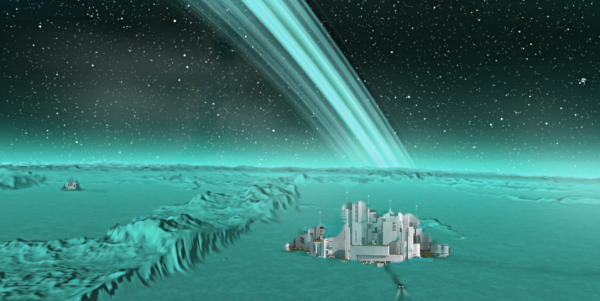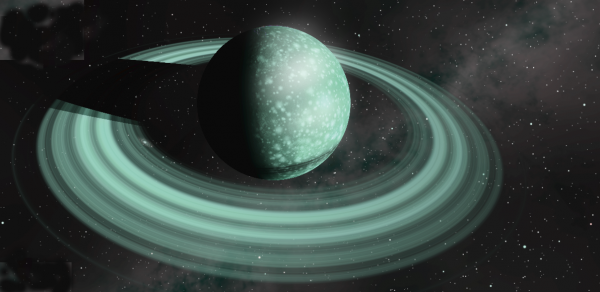BY LETTER
Utmig
Galactography > Regions of Space > Periphery
Galactography > Systems and Worlds > Systems & Worlds U - V
Galactography > Systems and Worlds > Systems & Worlds U - V
Icy world on the Periphery | |
 Image from Steve Bowers | |
| Two Methanoid citadels on the surface of Utmig | |
Star
Name: YTS 5010-910-018
Distance from Sol: 4010 ly
Type: K2V
Luminosity: 0.36 x Sol
Constellation: Auriga
Planet
Name: Utmig
Type: Ymirian.
Semimajor Axis: 7.9 AU
Diameter: 4630 km
Gravity: 0.15 gees
Mass: 0.02 x Earth
Utmig was the first world colonised by the spacecraft Diademata after that vessel left the Nexus. Because of its relative proximity to the nearest wormhole-connected system, this world has been in long-distance contact with the rest of the Terragen Sphere since the colony was established, and the details of society on this world are relatively well known.
The population of Utmig currently is composed of humanoid cold-temperature tweaks, known as Methanoids, who have a Type III metabolism which resembles that of the Muuh, and are most comfortable at temperatures around 114 K. The Methanoids move comparatively slowly, with a subjective experience of time that is less than one tenth as fast as that of a baseline human, but they make extensive use of neurally linked exoselves that are capable of much faster processing where necessary. Because of their planet's low gravity objects fall slowly, but their slower experience of time causes them to perceive objects to fall at near-normal speeds. When walking a Methanoid appears to move in slow motion, unlike faster humanoid clades, who tend to hop or lope in low gravity.
Methanoids have considerable strength when lifting or carrying objects because of the low gravity on their favoured worlds, although inertia is still a problem.
Although they call themselves 'tweaks, the Methanogens might be more accurately referred to as neogens, since they share very few genetic features with Earth life. Most of their genetic make-up and biochemistry is derived from alien lifeforms discovered on various icy worlds in the Inner Sphere and beyond, during the Age of Expansion.
Utmig's colonists live on the surface of the world in numerous small city-like structures known as Citadels, many of which are physically identical. Most citadels have high-bandwidth connections to the others, allowing the inhabitants to communicate in almost real-time (any time-lag is far too short for the Methanoids to notice without artificial assistance). In recent centuries Utmig society has made extensive use of eidolon telepresence technology, allowing any individual to maintain a remote presence in other citadels as well as eir own. Because most of the citadels have identical internal arrangements, even down to the arrangement of furniture and internal display options, the telepresent eidolons will experience the same environment wherever they happen to be.
In any particular citadel there is likely to be a number of citizens who are actually present, as well as a larger number of eidolons (typically two or three times as many). This means that each citizen is operating several additional bodies at any one time, and perceiving several different versions of the surroundings, each version having a different combination of persons interacting with each other, but otherwise (more-or-less) identical. These additional bodies can be operated comfortably by a single citizen, with the assistance of their exoself, which allows them to be conscious of up to four independent realities simultaneously. Since an eidolon can be transmitted to any location almost instantly, these multiple instances often disappear from one location and appear in another, making social interaction within the citadels very complex.
 Image from Steve Bowers | |
| Utmig's ring system, a relatively transient feature | |
Travellers who have visited this relatively remote world describe the society within these identical cities as both sluggish, due to the slow metabolism of the inhabitants, and mystifyingly complex, as the citizens constantly flit from citadel to citadel communicating with each other in various combinations.
Related Articles
Appears in Topics
Development Notes
Text by Steve Bowers
Initially published on 01 March 2014.
Initially published on 01 March 2014.






